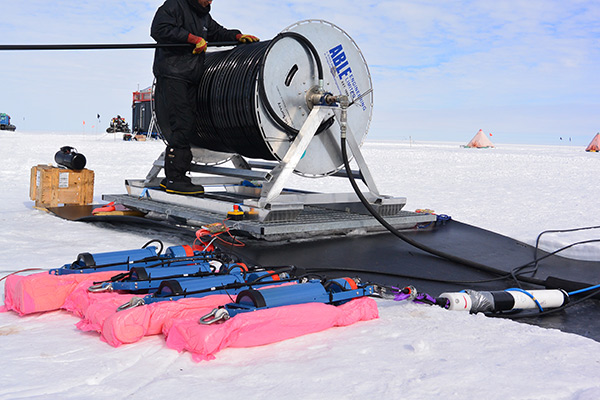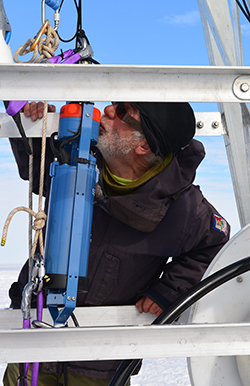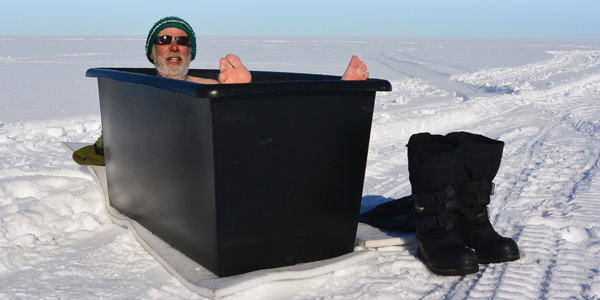Drilling into the Abyss to Understand Sea Level Rise
A rapid increase in sea level is a real threat if the larger ice shelves in the Antarctic disintegrate due to heat transportation from ocean currents.
Following disintegration of the ice shelves, the inland ice could move freely into the ocean causing an accelerated rise in sea level. Are the ice shelves heading for a quick disintegration? Or, are they actually growing, gaining, and becoming more stable? The answers lie below the 700-meter thick ice cover of the Filchner-Ronne Ice Shelf.
>> Download copy of Mission: Water Magazine
>> Download copy of the Article Only
Digging into the Science
In 2006, a series of icebergs struck New Zealand’s coast for the first time in almost a century. The icebergs, stemming from the Filchner-Ronne Ice Shelf, calved off in March 2000 and had an initial size of 167 kilometers by 32 kilometers. In order to study this calving and ice-ocean interaction, scientists from around the world have taken several missions to focus on what is happening hundreds of meters below the ice shelves.
To get through the ice, scientists have spent decades refining a technique of water drilling, enabling them to make real-time observations from under the ice.
One of the scientists who ventured to the Antarctic most frequently is researcher Svein Østerhus at Uni Research Climate. Østerhus, who holds the world record for measuring the lowest ocean temperature in the world at -2.6°C, has been going to the Antarctic since 1985. Having taken 12 trips there, his colleagues in Bergen joke he’s the only researcher with his own dedicated campsite in the Antarctic. During the winter months of 2016, he’ll once again camp out to collect more data on the integrity of the ice shelf.

Photo: Svein Østerhus
Østerhus’ focus has been to document the development of the ice shelves and predict the coming changes via modeling. Due to the cost associated with scientific missions to the Antarctic, there is less data from these areas, which could lead to missing important trends predicting sea-level rise. In order to conduct his research, he must venture deep into the Antarctic region, which requires research vessels, airplanes on skis, and hot water drilling for extended periods of time. Not an easy task for the faint of heart.
Hot Water Drilling
The hot water drilling is energy demanding and challenging, requiring many barrels of fuel to be transported onto the ice shelf. First, Østerhus’ team must heat up massive amounts of water. To do this, snow is melted in massive tubs and then a special hose is used to slowly melt through the ice. The drilling operation requires a steady supply of hot water and it is critical to perform at the correct pace, or one can easily start drilling sideways. Typically the drilling speed of 1.5 meters per minute can be achieved during the drilling operations, and no more. The end result is a 30-centimeter diameter hole, 700 meters deep into the ice shelf.
Once the hole has been drilled, Østerhus and his team need to move fast. Scientific instrumentation measuring water quality is lowered quickly through the ice shelf and the hole is left to freeze. At this point, it’s critical that the system deployed into the water below is working as expected. The team kisses each instrument goodbye before it goes into the deep, cold, dark waters. This is the last time this monitoring equipment sees the light of day. After deployment, the hot drilling water is used for other important purposes, such as giving the team a rare Antarctic hot bath on the ice. When data starts trickling in from the under-ice observatory and the scientists are relaxing in the tub, the project is officially a go.
A Kiss Goodbye
So what sort of equipment is used in these extreme conditions? Since the foundation of Aanderaa Instruments in the midsixties, there has been a close working relationship between the company and the internationally renowned academic institutions in the Bergen, Norway area says Østerhus.
Over the years Aanderaa has been engaged in instrumentation development, drawing on the experience from numerous projects in deep and challenging waters. The cooperation with academia has led to a company that has established itself internationally as an instrumentation provider and designer of complete, rugged water monitoring systems.
During the International Polar Year (IPY), Aanderaa and Østerhus developed a platform for long-term studies in polar areas. The result was the SmartSub, a product that can be used for observatories on the sea bottom both in shallow and deeper waters. “This is the only commercially available product that came out of the IPY program,” Østerhus jokingly stated.
The system used in the ice shelf project is a small under-ice observatory based on the SeaGuard instrument from Aanderaa. This instrument features a 500 meter long sensor bus, where sensors can be connected to various nodes at varying distances from the SeaGuard hub. In the setup utilized in the Antarctic, nodes contain a current sensor, with conductivity, temperature, and oxygen sensors attached.
From the under-ice observatory, there is a real-time communication cable frozen into the ice. Up top, a data logger stores the data relayed from the under-ice instruments and is housed in a protective cage. The team then buries the enclosure under a pile of snow to keep it out of the most brutal storms, which are common in the area. When Østerhus and his colleagues leave the arctic site, only a small flag and a set of antennas remain as evidence of their adventure.
Data is transmitted across the globe via Iridium satellite, and Østerhus is able to tap into the observatory under the ice in real-time from the comfort of his office in Bergen. “This is a huge benefit over previous installations,” says Østerhus. In the past, the data were a mystery as real-time access to the arctic was unavailable. Yearly missions were required to manually recover and replace the equipment and only then could scientists discover what was changing in the ocean underneath the ice. Today, Østerhus can view and download live data in an instant and look at processes under the ice as they happen.
Observations, so far, demonstrate that the melting of the Ronne Ice Shelf is currently decreasing; however, modeling shows that we can expect an increase of warmer water to be transported under the ice shelves in the coming decades. If this is the case, the melting rates can again increase and, at the extreme, could cause ice shelves to disintegrate.
Looking to the Future
So what is next for this scientist from Bergen? Being able to watch climate changes in real-time is one thing, but the next step is to develop an alarm system for the processes occurring under the ice. The worst-case scenario is the ice shelves are shrinking to the point they can no longer hold the in-land ice. Better safe than sorry, Østerhus is eyeing a system that accurately predicts sea level rise as it happens. But it may be some time before this technology is ready, so he and his team are in the process of planning another trip to the Antarctic during the winter of 2016 to deploy additional monitoring instruments. And according to tradition, the event will be celebrated with a hot bath.

Photo: Svein Østerhus
Mission: Water is a new magazine featuring the organizations and researchers who tackle the world’s most challenging water issues. It highlights the latest trends in instrumentation and research applications, while also offering additional educational resources on environmentally-focused matters.
Our goal is to help you stay informed about topics relevant to you. Our second edition covers articles ranging from monitoring sinkholes at a Corvette museum, drilling into the abyss in the Antarctic, life after the Horizon oil spill, work leading up to the World Cup in Qatar and much more!
